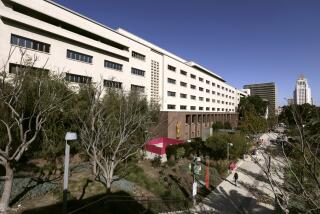Building in the Farrell Controversy Is Unsafe
- Share via
Los Angeles City Councilman Robert Farrell moved his district office into an old bank building last year despite warnings that the structure needed extensive repairs to meet earthquake safety standards, a city official said.
Since then, the city has paid rent for Farrell totaling $57,600 to the building’s owner, a small social service agency run by Farrell’s former wife, according to city records. The agency acquired the building in 1984 with Farrell’s help.
Farrell’s staff and the Improvement Assn. of the 8th District, whose executive director is Essiebea Farrell, could be forced out of the building as early as next month unless plans to repair the structure are filed by Tuesday, city officials said.
‘Have to Move Out’
“The councilman is not going to be able to stay there, or anybody else,” said Kenneth Mason, an attorney representing the improvement association. “Everyone in there is going to have to move out at some point in time unless the building is made earthquake-proper.”
Mason said the improvement association, which runs a small literacy and food distribution program in South-Central Los Angeles, does not have the resources to pay an estimated $180,000 bill to repair the structure. He said the association has applied for government grants to fix the building, which was constructed around 1930.
The previous owner, Security Pacific National Bank, closed the branch office in 1984 because of structural hazards and proposed donating the property to the city, according to Bradford Crowe, director of the mayor’s Office of Economic Development. Crowe said city officials, who were ecstatic over the gift, planned to demolish the building and use the land to launch a commercial redevelopment project in Farrell’s district.
But, according to City Hall sources, Farrell used his influence to divert ownership of the bank building and an adjacent parking lot--valued at about $225,000--to the improvement association.
Role of ‘Facilitator’
Farrell said in a telephone interview Friday that he does not recall being told by officials from the mayor’s office that the bank had offered the building to the city as a gift. He acknowledged that he played the role of “a facilitator” in bringing the bank and his ex-wife’s agency together to discuss the transaction.
The transfer of the building is one of several ways in which Farrell has helped funnel nearly $400,000 in financial support to his ex-wife’s agency since 1983. Farrell’s political committees have contributed $56,000 to the improvement association over the last four years, and Farrell joined the rest of the City Council a year ago in approving a $53,105 federal grant to the organization, city records show.
Conflict-of-interest regulations prohibit public officials from participating in decisions that benefit family members. Farrell, who was granted a divorce from Essiebea Farrell in September, 1986, is the subject of an inquiry by the district attorney’s office to determine if the councilman violated any criminal laws.
Farrell said Friday he works hard as a councilman to support all nonprofit social service agencies in his district, including the program run by his former wife.
“Part of my responsibility is to be an advocate of nonprofits in South-Central Los Angeles who seek to bring about change,” Farrell said. “It is a fundamental part of my political responsibility there. And I do it.”
Earlier this month, following press reports, the improvement association returned to the city $8,400 in rent payments it collected on former parking lot property it did not own. The nonprofit agency had failed to notify the city in March, 1986, three months after its lease began, that the parking lot had been sold and developed into an apartment building. It is unclear why Farrell’s staff did not notify the city that its parking lot had been put to another use by different owners.
In early 1984, the city first learned that the bank site was available when Hugh Loftus, director of community economic development at Security Pacific, approached Bradford Crowe.
‘Wanted to Dump It’
“Hugh told me the building was seismically unsafe,” Crowe said. “They wanted to dump it before they got in trouble with the city.” Loftus could not be reached for comment.
Crowe said Farrell responded enthusiastically at a June 7, 1984, meeting to the suggestion that the city precisely follow the same blueprint that enabled developers to use government funds to demolish the old Sears store at Vermont and Slauson avenues and build a new shopping center.
“I made it really clear in the meeting with Farrell that the building was not seismically safe,” Crowe said. “It was really in the best interest of all parties that the bank would close it, the city would demolish it and use it like we did for (the Sears building).”
But instead, Farrell moved his district office into the old bank building. He said he wanted to bring “the prestige and status of a council office” to help revitalize the business district along Vermont Avenue.
Following the Oct. 1 earthquake, Farrell’s staff requested that the city inspect the field office. The inspectors noted cracks throughout the interior and revealed that no earthquake work had been done on the building.
Under the current lease agreement, the city will continue paying $2,000 a month indefinitely for Farrell’s staff to occupy the office. Farrell had received free rent for his district office before his staff moved into the building owned by his ex-wife’s agency.
“How can they occupy a building that . . . had to be brought up to code or demolished?” asked a City Hall official familiar with the transaction who asked not to be identified. “Can you imagine the liability the city incurred by entering into a lease agreement for a building that the city itself had cited? It’s incredible.”
More to Read
Sign up for Essential California
The most important California stories and recommendations in your inbox every morning.
You may occasionally receive promotional content from the Los Angeles Times.













